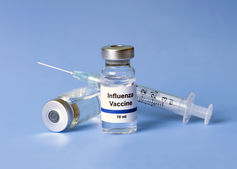Stay home if you get the flu / Shutterstock
By Dr. Patricia Schnabel Ruppert / 10.23.2016
Commissioner of Health, Fellows Ambassador New York Academy of Science, Distinguished Lecturer in Epistemology and Community Medicine, New York Medical College
Assistant Professor of Medicine, Columbia University Medical Center
Seasonal influenza is a major global health concern. Worldwide, annual influenza epidemics result in three to five million cases of severe illness, and about 250,000 to 500,000 deaths. In industrialized countries, most deaths associated with influenza occur among people age 65 or older, who are also 10-30 times more likely to be hospitalized due to influenza-related complications.
In the United States, the overall burden of influenza disease during 2014-2015 across all ages was 40 million flu illnesses, 19 million flu-associated medical visits and 970,000 flu-associated hospitalizations resulting in more than 36,000 deaths due to influenza-related complications.
You play an important role in stopping the spread of flu, not just to yourself but to others. As a doctor and public health professional who has treated many people with influenza, I’ll explain why.
And no, getting the vaccine will not give you the flu.
Protecting yourself also helps others
Almost everyone should get a flu shot, preferably before the end of October, though flu vaccine should still be administered until the season is over, usually by late spring. The influenza vaccine has been shown to be one of the most important preventive measures against the flu. Almost everyone can receive the flu vaccine. Exceptions include babies younger than six months and people who have serious reactions to the flu vaccine, like anaphylaxis, a serious and life-threatening reaction.
Some people gets hives from eggs, but this is not considered a serious reaction. If you are one of these people, it is still OK for you to get a flu shot from standard providers. Even those who have a serious egg allergy can get the flu vaccine in a medical setting.
Flu vaccine / Shutterstock
For the 2014–15 influenza season, the CDC estimates that influenza vaccination prevented about 67,000 influenza-associated hospitalizations, an estimated 1.9 million illnesses and 966,000 medical visits associated with influenza.
Getting the vaccine is not just good for you but also for the larger community. About 70 percent of the population needs to receive the flu vaccine to ensure what we call “herd immunity.” That happens when a critical portion of a community is immunized against a contagious disease.
When that occurs, most members of the community, including those who are not vaccinated, are protected against that disease because there is little opportunity for an outbreak. Even those who are not eligible for certain vaccines get some protection because the spread of contagious disease is contained. This can effectively stop the spread of disease in the community.
Matching the flu vaccine with the strains
The seasonal flu vaccine protects against the influenza viruses that research indicates will be the most common that season. In 16 of the past 20 influenza seasons, the viruses in the influenza vaccine were well matched to the predominant circulating viruses. Due to the large numbers of flu-associated illnesses and deaths in the United States, combined with the evidence from many studies showing that flu vaccination is not only safe, but provides protection, the current recommendations for flu vaccination are supported.
The World Health Organization works with labs that collect specimens from hundreds of countries to determine which viruses might be most common each year. Since flu strains move fairly predictably around the world, the decision of which strains of flu should be included in the annual vaccine is made months in advance.
There are three main types of influenza virus that cause disease in humans; A, B and C. Influenzas A and B are associated with more severe illness and are included by the WHO in the flu vaccine each year.
Sometimes, there are three strains in the flu vaccine, two A’s and one B. There is also a vaccine with four strains, with two each of A and B.
For influenza A, there are two major antigens, or proteins, on the influenza virus. The body reacts to an antigen with an immune response by producing antibodies.
Influenza antibodies develop in the body about two weeks after vaccination and provide protection against infection with the strains that are in the vaccine. They may also be of benefit for closely related strains.
The major antigens on the influenza A virus are H (hemagglutinin) and N (neuraminidase). They both have multiple subtypes and can combine as different strains of influenza, such as H1N1 and H3N2. Influenza B is named for the location and year first identified and the lineage, for example, B/Brisbane/60/2008-like virus (Victoria lineage).
Typically, hens’ eggs are used to make influenza vaccine. Vaccine manufacturers inject influenza viruses into fertilized hens’ eggs, which are then incubated for several days to allow replication. The virus-containing fluid is harvested from the eggs and formulated into the vaccine.
In injectable vaccine, the influenza viruses are inactivated, or killed. The intranasal vaccine is live, but is made from weakened flu virus. The CDC is not recommending the intranasal vaccine this year due to concerns of effectiveness.
Neither influenza vaccine causes the flu, but you may still get the flu even if you are vaccinated. That can happen if you are exposed to a strain that is not in the vaccine, or if you were exposed within two weeks of being vaccinated. Also remember that although no vaccine provides 100 percent protection, the vaccine can make what would have been a bad case of the flu a much milder one.
The CDC conducts studies to measure the benefits of seasonal flu vaccination each year. These vaccine effectiveness studies confirm the value of flu vaccination as a public health intervention. While vaccine effectiveness can vary, studies show vaccine reduces the risk of flu illness by about 50 to 60 percent among the overall population during seasons when most circulating flu viruses are like the vaccine viruses.
This effectiveness is a major benefit because the flu affects five to 10 percent of adults and 20 to 30 percent of children each year. For the 2015-2016 flu season, the adjusted overall effectiveness of the flu vaccine was 47 percent.
And remember, even if it’s not a perfect match, it can protect you and your loved ones from getting a potentially life-threatening, yet preventable, disease.
Other things to do, too
Cough into your elbow, not your hands. / Shutterstock
While the vaccine has been shown to be one of the most important preventive measures against the flu, you can do other things, too. Wash your hands. If you cough or sneeze, cover your mouth or nose with your sleeve, not your hands. Avoid those who are ill.
Antiviral medication can help you feel better if you contract the flu, but it must be started early in your illness, so call your health provider when symptoms begin.
Good advice: Stay home if you have the flu. Better advice: Get a flu shot!











